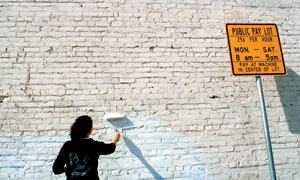The wall in question faces south, toward a parking lot between Main Street and Third Street in Kalispell, on the outside of a building that used to house Mimi’s Bridal shop. A few vague pieces of graffiti have been spray-painted on the wall, alongside a startling image of a man who resembles an insurgent fighter clutching a bouquet of colorful flowers with the words, “Wage Peace” stenciled nearby.
Last week, a group of teenagers began to clean up the wall and hang three murals in place of the graffiti. The kids, like the wall, are complex, multi-layered and strong, with flaws alongside beauty and virtue. But the wall and the kids are capable of improvement.
All of which makes the murals a fitting project for the Center for Restorative Youth Justice (CRYJ), the nonprofit agency responsible for displaying the large paintings downtown. Restorative justice, according to the agency’s executive director Jen Molloy, is an alternative to traditional justice systems that focus on punishment. CRYJ works with kids who have committed certain offenses, and seeks to impress upon them the harm done by the crime, what is necessary to repair that harm, and who is obligated to repair that harm.
“A lot of people think of community service as kids in a corner picking up trash by themselves,” Molloy said. “We don’t think that that necessarily helps kids; it doesn’t help reconnect them.”
On a recent evening, six teens gathered in the basement of the KM Building to sketch out their mural ideas on three large pieces of plywood. Some of the youth were volunteers, while others were accruing community service hours toward the sentence of an offense they had committed.
 |
|
Nichole Burke primes the side of a building at the corner of Main Street and Third Street West where the Center for Restorative You Justice is working to install a mural. |
Molloy admits she tasked the kids with three concepts of restorative justice that are difficult to represent visually on the separate murals: competency development, accountability and community safety. But the project aims to improve the teens’ self-esteem, and allows them to focus their energies on something they feel good about, she said.
Some of the teens dove right into the drawing, sprawled on the floor and sketching confidently. Others sat back and stared pensively at their corner of the artwork, drawing a line, erasing it, then trying again.
Hilary Slaughter, 17, designed most of the murals, and on this day she was sketching out one designed to convey the idea of “building peace as a community.” The drawing depicts a group of people standing around a floating block structure with the peace symbol emblazoned on the front.
“I just like drawing people,” Slaughter, a student at Flathead Valley Community College, said. “My dad taught me at a young age how to draw what I saw.”
Lily Shah, 17, worked alongside Slaughter, and had suggested the peace sign at the center of the painting. “I just like the idea of peace,” Shah, also an FVCC student said. “Pretty deep, huh?”
The Center for Restorative Youth Justice began 10 years ago as the Flathead County Peer Court, a function it still carries out. Thursday nights teens acting as attorneys, judges, bailiffs, jury members and other courtroom roles sentence a youth offender who has already admitted guilt. The sentences sometimes allow the youth to avoid a conviction on their record, but are always intended to be more meaningful and constructive than conventional punishments. The sentence may require appropriate apologies to the victims of an offense, education about alcohol or drugs, and any other type of personalized activity by the defendant that may make up for the offense. Everyone sentenced must also return to volunteer as a juror on the Peer Court in the future.
Three years ago, CRYJ began a victim-offender conferencing program, which facilitates a meeting between the young offender and the person whose business they may have harmed, to discuss restitution, repairing damage, and occasionally to participate in a mentoring relationship. “Youth Connections” is the third CRYJ program, of which the mural project is a part, which focuses on discussion groups with adult facilitators and alternative forms of community service.
“They’re not bad kids with ‘Youth Connections’ written across their foreheads,” Molloy said. “You have a new start, and their offenses are eligible for dismissal.” Though not all offenses are dismissed, she added.
CRYJ works with between 120 and 150 kids a year, and most sentences through the agency must be carried out within 90 days. With strong support by law enforcement and the local courts, Molloy believes her agency can serve as a model for the rest of the state.
The kids planned to have the wall whitewashed by the end of last week, and hang the murals this week, though by the end of the drawing session, it was clear the murals required more work before they would be ready to paint. As the teens began to leave, Slaughter sat up, as if coming out of a trance. She had been so focused on the drawing, she forgot the time.
“Is this volunteer work?” she asked. “It is, isn’t it?”